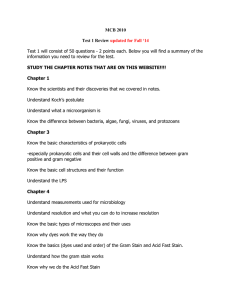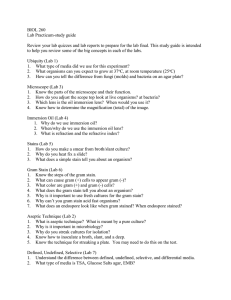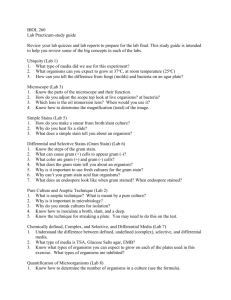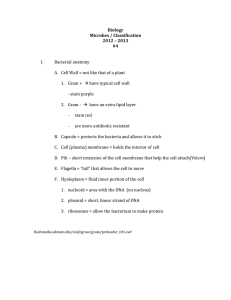Bio 280 Lab Practicum-study guide Exercise 1:Ubiquity
advertisement
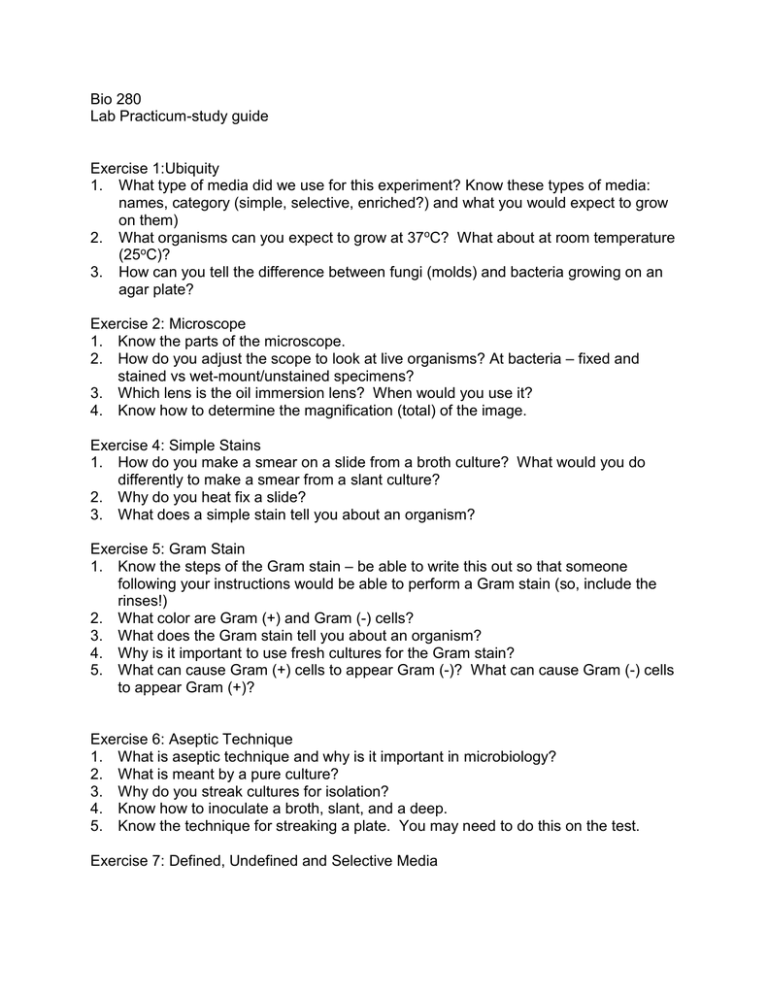
Bio 280 Lab Practicum-study guide Exercise 1:Ubiquity 1. What type of media did we use for this experiment? Know these types of media: names, category (simple, selective, enriched?) and what you would expect to grow on them) 2. What organisms can you expect to grow at 37oC? What about at room temperature (25oC)? 3. How can you tell the difference between fungi (molds) and bacteria growing on an agar plate? Exercise 2: Microscope 1. Know the parts of the microscope. 2. How do you adjust the scope to look at live organisms? At bacteria – fixed and stained vs wet-mount/unstained specimens? 3. Which lens is the oil immersion lens? When would you use it? 4. Know how to determine the magnification (total) of the image. Exercise 4: Simple Stains 1. How do you make a smear on a slide from a broth culture? What would you do differently to make a smear from a slant culture? 2. Why do you heat fix a slide? 3. What does a simple stain tell you about an organism? Exercise 5: Gram Stain 1. Know the steps of the Gram stain – be able to write this out so that someone following your instructions would be able to perform a Gram stain (so, include the rinses!) 2. What color are Gram (+) and Gram (-) cells? 3. What does the Gram stain tell you about an organism? 4. Why is it important to use fresh cultures for the Gram stain? 5. What can cause Gram (+) cells to appear Gram (-)? What can cause Gram (-) cells to appear Gram (+)? Exercise 6: Aseptic Technique 1. What is aseptic technique and why is it important in microbiology? 2. What is meant by a pure culture? 3. Why do you streak cultures for isolation? 4. Know how to inoculate a broth, slant, and a deep. 5. Know the technique for streaking a plate. You may need to do this on the test. Exercise 7: Defined, Undefined and Selective Media 1. Understand the difference between defined, undefined, selective, and differential media. Know what selective AND differential media are and how they work. 2. Be familiar with the media used in this lab: TSA, Glucose Salt agar, EMB: what types of organisms you can expect to grow on each of these? What types of organisms are inhibited? Exercise 8: Viable Cell Count 1. Know how to determine the number of organisms in a culture (use the formula). 2. Why is it necessary to dilute the culture? 3. What are the parameters for choosing a plate within a dilution series to do the count and calculation for determining your total number of organisms in a culture? Formula for determining total # organisms in a known volume of culture medium: Exercise 9: Aerobic/Anaerobic 1. What was the purpose of this lab? 2. Understand the difference between aerobic, anaerobic, facultative organisms. 3. Be able to identify the type of organism growing in a shake tube. 4. Why were shake tubes used for this exercise and not agar plates or broth? Exercise 12: UV light 1. What effect does UV light have on bacteria? Be specific – what molecule is affected and what is the actual chemical change in UV-induced damage? 2. Be able to read a series of plates that have been exposed to UV light. What can you use as a control? 3. What types of organisms should be more resistant to UV light? More sensitive? Exercise 14: Antimicrobial Drugs 1. What are the clear zones around the antibiotic discs called? 2. What does the Kirby-Bauer test tell you about an organism? 3. How do you determine antibiotic resistance or sensitivity based on the result of your disc diffusion test? 4. Be able interpret the results of KB tests. Know how the interpretations for different drug-bug combinations are determined. Know the limitations of your ability to interpret the “raw data” (zone size, relative zone sizes of different drugs), and know why you are limited. Exercise 15: Disinfectants Exercise 16: Transformation 1. What was the purpose of this lab? 2. What is transformation? 3. What was the source of the DNA? 4. What were the positive controls used in the lab? Why are they important? 5. Which combination on the plates demonstrated the actual transformation? 6. How did you determine if transformation actually occurred? Exercise 22: Normal Skin flora 1. What types of organisms were we looking for in this exercise? 2. Why did we incubate some plates in the anaerobic chamber? 3. What types of organisms could grow on both the aerobic and anaerobic plate? 4. Why did we use a shake tube? 5. What does a (+) glucose brom cresol purple slant look like? What does that tell you about the organism? Exercise 23: Respiratory (throat culture) 1. What types of organisms are normal flora of the throat? What type of agar was used? 2. Be able to identify the different types of hemolysis on a blood agar plate. 3. What type(s) of hemolysis is seen with organisms considered normal flora? What indicates potential pathogens? Exercise 24: Gram negative rods 1. What color is a (+) phenol red fermentation test? What does a (+) test tell you about the organism? 2. What is the indicator in the phenol red fermentation test? What does it indicate? 3. What does the durham tube tell you? 4. Understand the significance between the MR and VP tests. 5. Be able to read a positive and negative test for each of the biochemicals used in this lab. 6. Know whether or not you need to add a reagent to the test before reading the results. Are there any pH indicators? 7. Understand what each test is telling you about the organism. Exercise 32: Water testing 1. Be able to interpret an MPN test - which lactose tubes are positive? 2. What is the MPN index? 3. Why do you plate (+) BGLB tubes onto LES Endo plates? 4. Be able to interpret a culture growing on an LES endo plate. 5. What types of organisms are you looking for in the water test? Why do we care?
